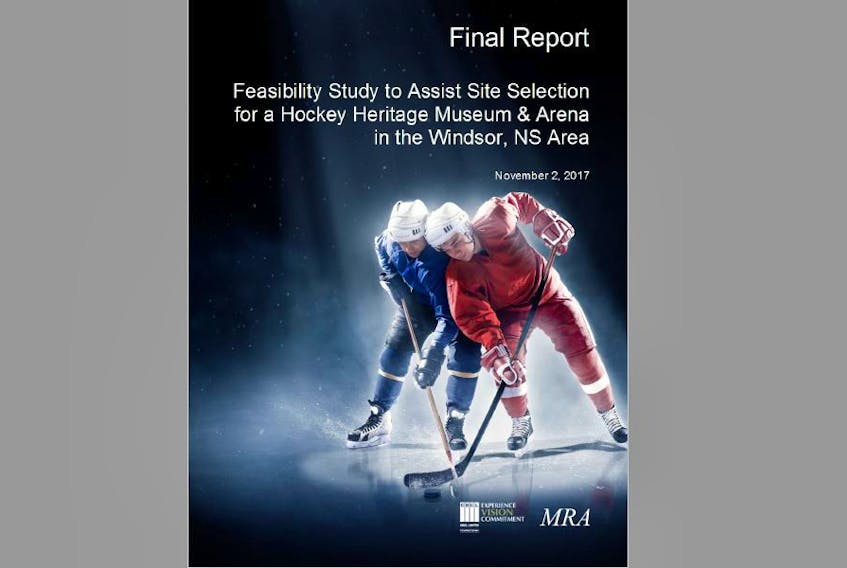WINDSOR, N.S. — The results of a feasibility study weighing the pros and cons of constructing a new hockey arena and museum in Windsor is out — and while it doesn't determine the best site, one location does appear to be more advantageous.
The study, released Nov. 14 to Windsor and West Hants councils plus the stakeholders involved with the project, was commissioned by the Atlantic Canada Opportunities Agency, Communities, Culture and Heritage, and the Department of Transportation and Infrastructure Renewal. The purpose was to review the site proposals (near Long Pond and King's-Edgehill School, or on the present exhibition grounds on Wentworth Road) and provide analysis on the overall project sustainability.
The report does not indicate which site is superior, however, it does point out the merits and weaknesses of both locations.
How the proposals stack up
The breakdown of the Long Pond site proposal includes six strengths, 13 weaknesses, four threats and three opportunities while the Windsor Agricultural Society's proposal has 14 strengths, 11 weaknesses, four threats and five opportunities.
One of the main strengths of the Long Pond site is that it will give visitors an authentic Birthplace of Hockey experience by being able to better tell the story on-site. Another strength is that the museum component on site will further cement the region's claim to being hockey's birthplace.
One of the threats associated with the Long Pond project is that the Dill Family Farm will maintain ownership of the pond and there is no continuity agreement for long term access to the site. The arena would be situated on land near the fabled pond, which would have to be purchased.
Among the weaknesses of the project is that it costs more than the alternative proposal, the site “is appealing to extreme hockey fans, but may miss other markets,” and, by not having a designated museum (the artifacts are to be displayed on the walls), there isn't a way to guarantee admission revenue.
The costs associated with upgrading the roads leading to the site also have not been factored into the final projected cost. Mainly residential streets lead to the Long Pond site, with the roads being “narrow, with no verge, no lane markings, and pass by many residential properties.” These streets, like College Road and King's-Edgehill Lane, do not have sidewalks or crosswalks and are not designed to handle high volumes of traffic or large vehicles.
It's noted that the Wentworth Road proposal provides “great visibility and accessibility” as it's located near Highway 101 and amenities. There's about 20 per cent more seating proposed in the agricultural society's pitch with the option of adding more seats, there's a designated space for a museum (so admission can be more easily charged), and there could be “synergies in management and promotion costs/shared staffing.”
Among the weaknesses, it's noted that the site doesn't have a direct connection with hockey's heritage and that the building will likely require upwards of $700,000 in flood mitigation work.
Other items noted in the report indicate that the exhibition grounds is considered well-established and already attracts about 250,000 visitors annually.
The consultant noted that “a new facility, no matter where it is located, needs to be designed to adequately accommodate present and future growth.” As such, plans for the the museum's size, for example, should be increased.
Local reaction
West Hants Warden Abraham Zebian said in a brief interview Tuesday night that he's still reviewing the document.
“It looks like it touches on many things that would be important for a council (to review) to make its final decision — it talks about sustainability, it talks about long terms future growth, it talks about the social aspects. It's talking about many things that we should always consider before we expend public funds to build anything,” said Zebian.
As councillors only received the report that night, Zebian said council will need “some time to digest it.” Discussion on the report may be brought forward at the next committee of the whole meeting, which is Nov. 28, or, Zebian said, at a special council meeting.
Windsor Deputy Mayor Laurie Murley received the report the morning of Nov. 15 due to an email issue and said she hasn't had the opportunity to thoroughly review the findings. She said Windsor council will discuss the topic at the Nov. 21 strategy and policy meeting. The 7 p.m. session is open to the public.
“We are really happy that it is finally out, I can say that,” said Murley.
“We put the letter and the study on the website so people can access it and have a look at it and send us information if they need to,” she added.
Greg Kelley, the president of the Long Pond Arena Society, said he had a chance to quickly read over the report and found it to be a reasonable study, but one that doesn't take everything into account.
“I think, like all studies, they look at some of the information that's in front of them at the time,” said Kelley. “I don't think there's anything absolutely concrete that anybody could take from the study. It's really just a straightforward comparison and I'm not sure if captures the true nature of either proposal.”
Kelley said he's pleased the study is complete and is looking forward to seeing a positive project for the community get underway.
“We've waited a long time for the study and now we have it. I'm sure it's one of those things that will generate some conversation,” said Kelley. “I'm just hopeful that as a community, we can get together and move this thing forward as quickly as possible and get this done.”
Lisa Hines, the president of the Windsor Agricultural Society, also didn't have much time to read the report but said she found the document contained some “pretty common sense” items.
That being said, Hines said there were a few areas that took her by surprise.
The first was the mention of flood mitigation being required for the exhibition site.
“If a dyke fails and we lose the arena then we'd be losing a whole lot of other buildings as well,” Hines said, noting that a large portion of the Town of Windsor is built on land known as the Tregothic Marsh.
The other item she highlighted was the fact that limited information was provided about the cost of the road upgrades that would be required if the Long Pond venue was selected.
“I guess it was outside the scope of the study but I still don't understand the real cost of accessing an arena beside Long Pond,” Hines said. “If all things are equal, those costs should be included in the cost of the facility. If you have to build a road to get there, that should be part of the real cost.”
As the two councils prepare to wade through the findings of the feasibility study, Hines said she's hopeful the best possible project will be selected.
“I hope that they will take a practical approach to this and make decisions on good, sound math,” she said.
RELATED ARTICLES
Want to read more about this project? Here are some previous stories.
- Provincial Long Pond funding announced (http://www.hantsjournal.ca/news/local/world-class-rink-in-the-works-for-windsor-50223/)
- Construction set for Long Pond/KES location (http://www.hantsjournal.ca/news/local/birthplace-of-hockey-arena-set-for-construction-near-kings-edgehill-school-49902/)
- Joint ownership between Windsor, West Hants councils given go ahead (http://www.hantsjournal.ca/news/local/windsor-west-hants-councils-give-birthplace-of-hockey-arena-go-ahead-1355/)
- Windsor Agricultural Society pitches the exhibition grounds as prime location (http://www.hantsjournal.ca/news/local/alternative-location-pitched-for-windsors-new-arena-hockey-museum-1532/)
- Reaction to Windsor Agricultural Society's pitch (http://www.hantsjournal.ca/news/regional/windsors-heritage-arena-stakeholders-react-to-agricultural-society-offer-1523/)
- Windsor mayor rooting for Long Pond site after KES pulls funding (http://www.hantsjournal.ca/news/local/windsor-mayor-hopeful-long-pond-location-will-prevail-for-hockey-heritage-arena-1795/)
- Federal funding for project up in the air (http://www.hantsjournal.ca/news/local/federal-funding-for-arena-project-still-up-in-the-air-brison-1828/)
- Hants West MLA requests feasibility study (http://www.hantsjournal.ca/news/local/hants-west-mla-wants-feasibility-study-conducted-for-new-arena-1823/)









